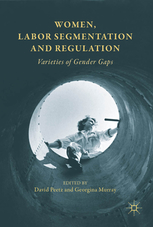Professor David Peetz and of the Centre for Work, Organisation and Wellbeing, and Professor Georgina Murray have released a new book that they have edited that aims to reshape how we look at gender gaps.
The concept for Women, Labor Segmentation and Regulation: Varieties of Gender Gaps comes from Peetz’s 2015 article in the Cambridge Journal of Economicswhich explains that the nature of gender gaps varies between situations and there is no single explanation for those gaps.
“By gender gaps, we are mainly talking about the difference in pay between men and women, but also differences in other aspects such as conditions and exposure to things like harassment,” Professor Peetz said.
“I have done some research in a number of different industries, and it struck me that when you are looking at gender gaps affecting women in particular areas the nature of the differ. They are differing according to how regulated or unregulated the particular occupation is and the gender composition of it.”
Women, Labor Segmentation and Regulation, looks at specific case studies through a number of fields, including coal mining, public sector professionals, academics, senior management, garment makers and those involved in film and television production.
According to Peetz, women working in a highly regulated field dominated by women such a childcare and nursing have historically experienced a collective undervaluation when compared to male occupations the require a similar level of skill.
“When you look at male-dominated occupations then the work is not undervalued but often the work of individual women is, but there are limits to that depending on how regulated the job is,” Peetz said.
“So if we look at coal mining, which is highly regulated, then pretty much women are getting equal pay for doing the same sorts of work and it is not undervalued. However, women will find it hard to do the sorts of work that is well paid because of difficulty to access to training, discrimination that might prevent that or encourage them to leave and home responsibilities that gender norms put upon them.”
The coal miners case study shows that while the work may be the same for both genders, the level of household responsibilities significantly differs between men and women, which plays into the differences from norms in the workforce.
“When you’re talking about an unregulated environment there is discrimination when it comes to pay itself,” Peetz said.
“We looked at CEO’s and senior managers and what you find is not only do you have those barriers in advancement that you see in regulated areas like coal mining, but you also have straight undervaluation of the women’s work themselves.”
“One of the biggest pay gaps you get between men and women is at the top of the food chain, amongst managers and CEO’s.”
“When you move away from regulation you are not moving to an area with the operation of a free market that sets pay, you are moving to an area where norms play an important role. Those norms matter when you can see the gender when you see the person across the table.”
That idea is put to the test according to Peetz when it comes to studies in bidding for work online using services such as Airtasker.
“When you can’t see or tell the gender of the person that is bidding for work then basically men and women will get similar pay,” Peetz said.
“When you can tell gender then there all sorts of opportunities for discrimination to arise, and indeed technology, with things like Gamergate, is one of the areas where there is one of the most entrenched forms of discrimination and harassment against women.
Overall, Professor Peetz hopes that readers of the book will come away with the value of regulations when it comes to gender in the workplace, and that goes beyond just an equal rate of pay.
“It’s important to think of regulation not just in terms of the regulation of equal pay at work, but there should also be regulations on things that give women access to the labour market, like parental leave, unpaid parental leave rights, part-time employment, and the flexibility that both women and men have to balance domestic and work needs,” Peetz said.
According to Professor Peetz, the issues of gender regulation inequality has made great strides in Australia over the years, but more work still needs to be done.
“In the mid-1960’s Australia had one of the worst gender gaps amongst advanced countries, buy the 1980’s it had one of the smallest gender gaps because the nature of award regulation and centralised wage fixing enabled the regulation of actual rates of pay,” Peetz said.
“Since the 1990’s we had various forms of decentralisation in wage fixing and there had been no progress in reducing the gender pay gap since then.”
